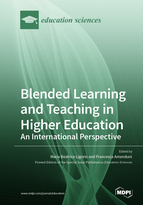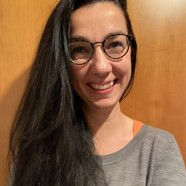Blended Learning and Teaching in Higher Education: An International Perspective
A special issue of Education Sciences (ISSN 2227-7102). This special issue belongs to the section "Higher Education".
Deadline for manuscript submissions: closed (31 July 2021) | Viewed by 22165
Special Issue Editors
Interests: education; technology; virtual communities; blended learning
Special Issues, Collections and Topics in MDPI journals
Special Issue Information
Dear Colleagues,
The journal Education Sciences (ISSN 2227-7102) is currently running a Special Issue entitled “Blended Learning and Teaching in Higher Education: An International Perspective”.
We are all keenly aware of the effects that the current pandemic has had on the various aspects of our daily lives. When it comes to education, the main effect was having to rapidly switch from face-to-face to remote or at a distance teaching. This is of course a completely new type of educational setting, but it has already attracted a great amount of research. Another aspect which is similarly relevant, however, is identifying what will happen and where we will stand once the pandemic subsides or is over. Blended learning seems to be a favorable solution and is a field which has already attracted some attention, but what we now need to do is re-focus on this, capitalize on the lessons learnt from the current situation, and combine them with what we already know from past research.
Blended learning, in its basest definition, encompasses the possible combination of computer-mediated and face-to-face teaching. It is not a simple juxtaposition of physical presence and technological mediation, but rather a well-studied alternation of the two, aimed at making the most of the various components and designing effective work contexts for both students and teachers.
Although this definition of blended learning is generally accepted, a huge variety of practices have been developed under this terminology. In the light of the new technological awareness that educational settings have reached now, there is a need to provide more detailed instructions and suggestions on how to design, implement, monitor, and assess blended learning; for instance, what type of communication modes—i.e., asynchronous or synchronous—should be involved and how they can be interconnected; what learning models should be evoked and how they can be intertwined; and what cognitive and social processes are involved.
We need to better understand the role multimedia products together with the various platforms can play; how to involve, at the same time, participants who are physically present and those who are observing a lesson or lecture digitally; how moments of face-to-face work should be interspersed with work at a distance, e.g., what comes first and what after and how they come into synergy with one another.
This Special Issue is aimed at collecting recent experiences, reflections, and empirical evidence regarding ways to effectively blend computer-mediated and face-to-face teaching, by dealing with current open challenges highlighted in literature, such as (but not limited to):
- How to incorporate flexibility in blended learning;
- How to stimulate interaction;
- How to facilitate students’ learning processes;
- How to foster an affective learning climate;
- The role of students’ self-regulation in blended learning;
- Teachers’ digital skills and their capabilities of using technology for teaching;
- Challenges in the provision of suitable instructional technology and effective training support to teachers by educational institutions.
Prof. Dr. Maria Beatrice Ligorio
Dr. Francesca Amenduni
Guest Editors
Manuscript Submission Information
Manuscripts should be submitted online at www.mdpi.com by registering and logging in to this website. Once you are registered, click here to go to the submission form. Manuscripts can be submitted until the deadline. All submissions that pass pre-check are peer-reviewed. Accepted papers will be published continuously in the journal (as soon as accepted) and will be listed together on the special issue website. Research articles, review articles as well as short communications are invited. For planned papers, a title and short abstract (about 100 words) can be sent to the Editorial Office for announcement on this website.
Submitted manuscripts should not have been published previously, nor be under consideration for publication elsewhere (except conference proceedings papers). All manuscripts are thoroughly refereed through a double-blind peer-review process. A guide for authors and other relevant information for submission of manuscripts is available on the Instructions for Authors page. Education Sciences is an international peer-reviewed open access monthly journal published by MDPI.
Please visit the Instructions for Authors page before submitting a manuscript. The Article Processing Charge (APC) for publication in this open access journal is 1800 CHF (Swiss Francs). Submitted papers should be well formatted and use good English. Authors may use MDPI's English editing service prior to publication or during author revisions.
Keywords
- blended learning
- higher education
- educational technologies
- computer-mediated teaching







